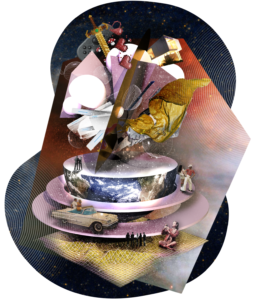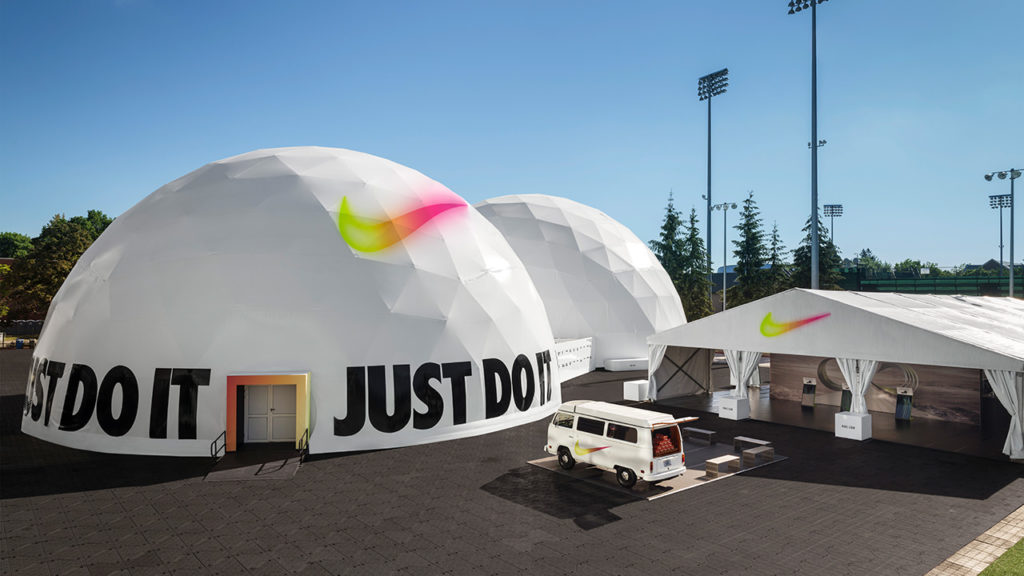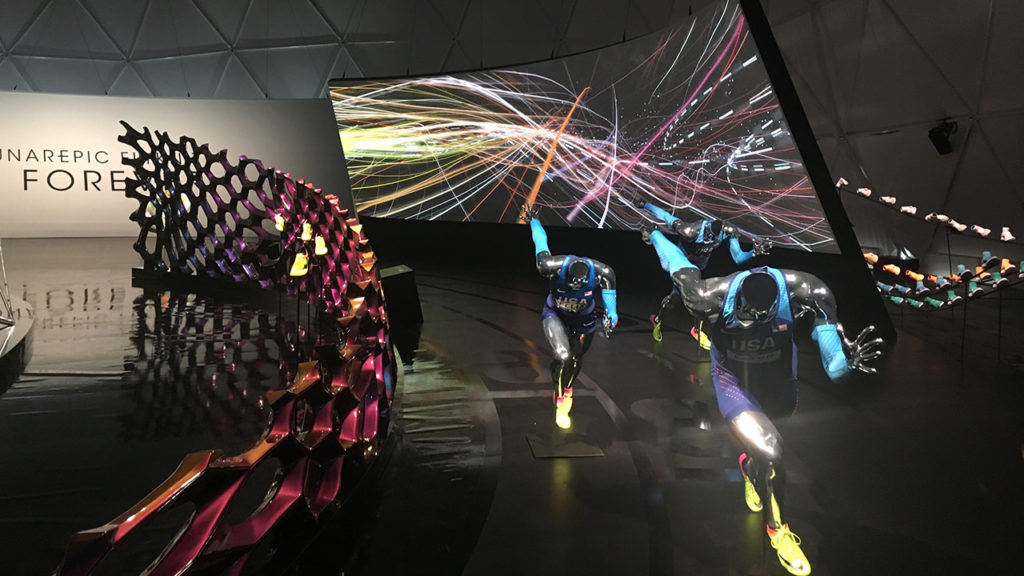The Brand Residency
Posted March 9, 2021

A “brand residency” is the natural evolution of everything the experiential industry has been working on for the past decade– a traveling experiential business center that plants roots for a season, absorbing the neighborhood culture, before changing locations. But before I get into that, let me give you some background.
Popups/Events
While I was working in experiential marketing, clients always asked if what we were making could travel. Of course it could have traveled, but that brought these experiential pop-ups more into the experiential products realm. And that meant more money and time, something brands don’t have when they need to get something live in eight weeks for Coachella or SXSW.
Something that always ate at me was that the final experience we created for many brands, with a little more tinkering and maintenance, could have been permanent. They were built to run nonstop for months and take a serious beating from kids and drunk people. I also hated watching all the pieces get thrown in the dumpster at event end, or worse, watching as the brands stored these things for years and then threw them out on the curb without asking for a refresh.
EBCs
On the flip side, now that I am working solely in the realm of permanent experiences, the idea of the executive business center (EBC) needing a refresh comes up often. Brands need new exciting ways to tell their stories, and as businesses become more global, having one location to experience a brand doesn’t make sense.
Additionally, the idea of the EBC has shifted currently to be more of a B2C, such as Samsung 837 or Lexus Intersect. Which works in terms of bringing awareness to a brand through cool events and activations; but doesn’t directly or indirectly translate into ROE — return on experience.
Samsung 837. Photo Credit: Samsung
. . .
Awareness, which used to be the sole metric in Experiential, isn’t enough anymore. Brands need to see the next step, and understand how awareness translates into increased revenue, new metrics, and staff retention.
Of course due to COVID-19 and social-distancing measures, event pop-ups aren’t really happening at all and most EBCs are temporarily closed. We expect this to be temporary, and now is a great time to pivot to some new thinking and make plans for the future.
Let’s explore some ideas together for how a fictional gaming company, fashion brand, and tech firm can expand the footprint of their traditional EBC into a Brand Residency and in the process generate Return on Experience.
Miniverse
Miniverse makes prosumer tech products. Their current EBC has their products and services on display in various scenarios. Some are projection mapped with the latest graphics, and some sit on cool multitouch tables. They all require a lot of setup and maintenance, and can only be seen at the Miniverse EBC in Detroit.
They commission a Brand Residency…
The Miniverse EBC is reimagined as a traveling social space that exists in three simultaneous networked locations. Having multiple venues opens up new forms of cultural connection and real time collaboration.
At a local artist designed product display in Kansas City, a guest interacts with Miniverse AR (Augmented Reality) glasses and paints a virtual landscape. At the same time, in the Tokyo Miniverse space, another guest paints animals on that virtual landscape. And a third guest at the São Paulo Miniverse space writes poetry that flows throughout this AR world. Wonderful!
In another area of the Miniverse spaces, Miniverse cybersecurity products and services are set up as multi-location escape room. In the escape room, potential clients have to work together with other guests at different Miniverse escape rooms around the world to solve puzzles, unlock goals, and fix a mysterious security breach. This is a physical-meets-digital immersive scenario, where a guest has to be at each location to open real doors, and, of course, use products.
As mentioned, these experiences are completely set up as social spaces. All the product displays are Insta-moments aesthetically, but also in a real way. When guests collaborate with other locations, that interaction gets posted to the Miniverse brand accounts.
Lastly, utilizing existing empty storefronts and galleries, Miniverse works out deals with landlords a year in advance. Removing the challenges I mentioned of having a static permanent EBC or uncontrollable popup event dates. With that in place, they are able to plan all programming and marketing strategically for the year, and free up budget that typically goes towards events.
Thunderlion
Thunderlion is an AAA level gaming company. Every year they devote their marketing efforts for a new IP launch at Comic-Con and E3. In 2020 that didn’t happen, so now they are looking for alternatives. They are looking at ways to enhance their HQ to update the space for fans to playtest updates and new IPs, as well as gather further product funding.
They commission a Brand Residency…
Since their gamers are global, they set up a traveling eSports mini-arena. A modular experience system called “World Blocks” is created exclusively for Thunderlion. A single World Block crates and unpacks into a full station for an individual gamer. Each station is equipped with an outward facing LED that can be used for digital signage and player stats. Individual World Block modularly fit together for gamer teams, and also produce larger outward facing LED displays. World Blocks can also be configured into interactive experiences branded with Thunderlion’s IPs. For example, a series of World Blocks could be stacked into a walkthrough cityscape to portray an apocalyptic game world.
Thunderlion works out consecutive four month agreements with landlords of unoccupied large white box spaces, with options to extend. In time, these mini-arenas become coveted neighborhood eSports spaces, not unlike the local soccer field. With this, Thunderlion begins to become a household name, gaining new revenue alongside their game IPs. Every four months, fans can vote on a new location for a World Cube arena set up.
At these arena sites, fans, locals, and playtesters are welcome to try unreleased games, build buzz, and, best of all, compete. And potential publishers, typically separated from users, can get excited alongside everyone.
L’eon
L’eon, an iconic fashion brand, has a pop-up every year at Fashion Week. As they have shifted towards ready-to-wear, they are looking to reach a wider audience. Though many fashion houses have gone to virtual runway, they don’t have the same impact as in-person pop-ups. Pop-ups are a large one-time cost and don’t give the consistent positive metrics to warrant a good ROE.
They commission a Brand Residency…
L’eon has retail stores across the globe; looking to the future, they turn these stores into Experience Fashion Houses. There are stores currently that try to do this, but the brand residency approach adds a much needed element of neighborhood.
First, local artists are selected to takeover select stores. Then, they transform the stores into galleries that support, yup, you guessed it, artist residencies. The takeover is also a crossover with L’eon merchandise, creating coveted local-only items and unique digital fashion. An important aspect of the artist takeover is interactive, with repeatable digital VIP activations that are shareable, but also gather vital metrics on the shoppers.
Next, local customers are invited to pay for merch using “Social Currency,” credits they have racked up credits with every social media post. L’eon supplements their traditional marketing campaigns with user generated content that pushes brand love out to fans, creating a larger online community and tracking fan habits.
By inviting local culture trends in and gathering metrics from the experiences, L’eon now knows exactly what the public wants. Using this data, all future programming for the Experience Fashion Houses are tailored specifically for each space automatically, pivoting static fashion retail to a new evolving format.
. . .
In summary, the brand residency takes the best aspects of event popups and EBCs and creates a mashup, where each can co-exist and thrive. It also starts to answer and solve many of the challenges with each, namely location, lifespan, metrics, and conversion. The meta-concept for this entire idea is geared towards ensuring brands become immersed in the local culture, hence the term “residency”. Because I believe engaging with a neighborhood’s history, people, and future, is key in creating a lasting emotional connection with brands.





Join The Conversation